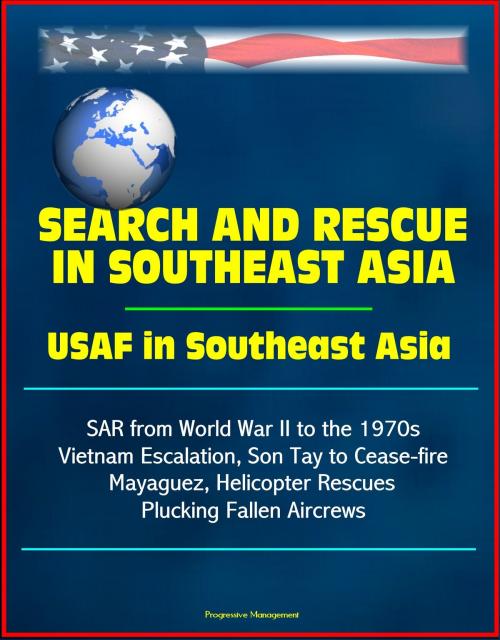Search and Rescue in Southeast Asia: USAF in Southeast Asia - SAR from World War II to the 1970s, Vietnam Escalation, Son Tay to Cease-fire, Mayaguez, Helicopter Rescues Plucking Fallen Aircrews
Nonfiction, History, Military, Vietnam War, Asian, Aviation| Author: | Progressive Management | ISBN: | 9781310094552 |
| Publisher: | Progressive Management | Publication: | August 7, 2015 |
| Imprint: | Smashwords Edition | Language: | English |
| Author: | Progressive Management |
| ISBN: | 9781310094552 |
| Publisher: | Progressive Management |
| Publication: | August 7, 2015 |
| Imprint: | Smashwords Edition |
| Language: | English |
Professionally converted for accurate flowing-text e-book format reproduction, this Air Force publication offers the reader an exciting and exacting history of the evolution of combat search and rescue in America's longest and most grueling war: the conflict in Southeast Asia.
Chapter 1 - The Development of Search and Rescue: World War II to 1960 * Chapter 2 - The Genesis in Southeast Asia * Chapter 3 - The Period of Escalation: 1964-1966 * Chapter 4 - The Coming of Age: 1967-1970 * Chapter 5 - Son Tay to Cease-fire: 1970-1973 * Chapter 6 - Cease-fire to Mayaguez
Search and rescue has always been important to the United States Air Force, whose aircrews deserve nothing less than the fullest possible commitment to save them and return them home. The motto of Air Force search and rescue, "So Others May Live," is one of the most compelling of all military mottoes. It embodies this spirit of altruism and, as events have proven, also indicates the service's intention to furnish life-saving SAR for civilian as well as military purposes.
Search and rescue flourished during World War II as lifeguard ships and submarines joined patrolling aircraft in saving lives and sustaining morale, especially in the Pacific Ocean Areas. The rotary-wing, turbojet, and avionics revolutions made modern SAR a reality. Foreshadowed by the Korean War, the helicopter became the principal form of air rescue vehicle in Vietnam. In three major conflicts, SAR forces gained a reputation for bravery, dedication, and self-sacrifice, as they ventured repeatedly into hostile territory to pluck fallen aircrews to safety.
The USAF rightly continues to place a top priority on search and rescue, seeking better ways to perform this function through the use of advanced equipment and aircraft (such as the multipurpose MH-53J Pave Low helicopter) and improved training of personnel.
Professionally converted for accurate flowing-text e-book format reproduction, this Air Force publication offers the reader an exciting and exacting history of the evolution of combat search and rescue in America's longest and most grueling war: the conflict in Southeast Asia.
Chapter 1 - The Development of Search and Rescue: World War II to 1960 * Chapter 2 - The Genesis in Southeast Asia * Chapter 3 - The Period of Escalation: 1964-1966 * Chapter 4 - The Coming of Age: 1967-1970 * Chapter 5 - Son Tay to Cease-fire: 1970-1973 * Chapter 6 - Cease-fire to Mayaguez
Search and rescue has always been important to the United States Air Force, whose aircrews deserve nothing less than the fullest possible commitment to save them and return them home. The motto of Air Force search and rescue, "So Others May Live," is one of the most compelling of all military mottoes. It embodies this spirit of altruism and, as events have proven, also indicates the service's intention to furnish life-saving SAR for civilian as well as military purposes.
Search and rescue flourished during World War II as lifeguard ships and submarines joined patrolling aircraft in saving lives and sustaining morale, especially in the Pacific Ocean Areas. The rotary-wing, turbojet, and avionics revolutions made modern SAR a reality. Foreshadowed by the Korean War, the helicopter became the principal form of air rescue vehicle in Vietnam. In three major conflicts, SAR forces gained a reputation for bravery, dedication, and self-sacrifice, as they ventured repeatedly into hostile territory to pluck fallen aircrews to safety.
The USAF rightly continues to place a top priority on search and rescue, seeking better ways to perform this function through the use of advanced equipment and aircraft (such as the multipurpose MH-53J Pave Low helicopter) and improved training of personnel.















